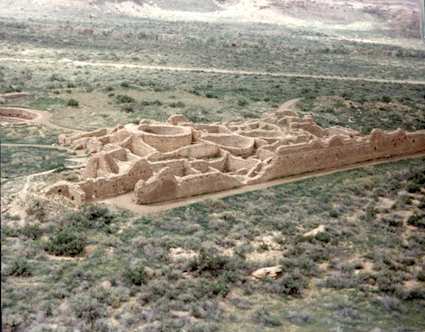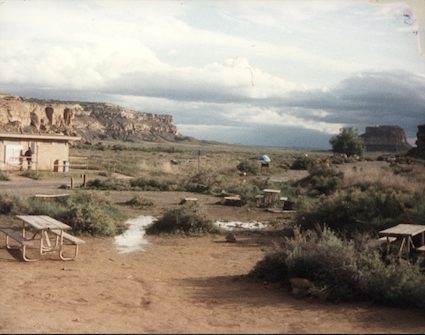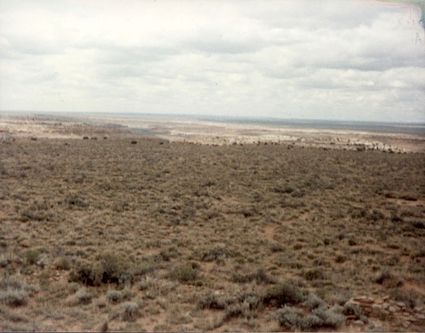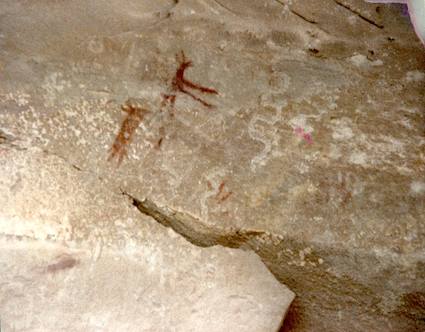San Juan Co., New Mexico, USA (May 1992)

We spent much of a day and drove more than four hundred miles without ever leaving the state of New Mexico. That morning we left Carlsbad in the far southeastern corner destined for Chaco Culture National Historical Park in the for northwest. First we passed Roswell, looking for but never spotting any aliens. Then we drove through Albuquerque. Finally we pushed through increasingly remote terrain including a final thirteen miles on dirt roads before arriving at the park (map). This became my initial introduction to Chaco Canyon, and I didn’t return again until 2017.
That rugged road served as an ingenious device for protecting the greatest concentration of pre-Columbian pueblos in the United States from the crowds that would love them too much. Only about 40,000 people make it here during a typical year. That equaled a little more than a hundred visitors per day on average, spread throughout the vast acreage of the park.
Serious touring awaited along the Chaco Wash, the arroyo – or intermittent stream – that carved out the canyon. Here the Chacoan Anasazi built their pueblo great houses during the period 850 through 1150. They started first with Pueblo Bonito, Una Vida, and Peñasco Blanco. They followed followed with Chetro Ketl, Pueblo Alto, and Hungo Pavi. Fifteen of these large structures filled the canyon by the time these skilled builders stopped building for unknown reasons.
Initial Impressions

What an amazing reward greeted us as we arrived. We spotted those remarkable Anasazi pueblos that stood within Chaco Canyon for centuries. Later in the trip we also visited Mesa Verde (see my Mesa Verde page). However, we agreed that the Chaco Canyon ruins appeared similarly impressive, quite a bit larger and much more accessible than their more famous brethren. I’m still somewhat surprised that Mesa Verde gets most of the attention.
We arrived late in the day and settled into the campground, intending to visit the cultural sites the next morning. The grounds where we parked our RV provided spartan restrooms with cold running water but not much else. For the most part it was just us and nature. A massive thunderstorm rocked the campground overnight, with large forks of lightning silhouetting the sky and Fajada Butte in the distance. We awoke refreshed and began our tour.
A Center for an Entire Culture

Chaco Canyon served as the cultural center for these early Native Americans. A vast road infrastructure connected sites far-and-wide. Various theories of archaeoastronomy attempted to explain the network. Some experts believed that the alignment of roads and buildings may have been designed to match various solar and lunar cycles.
The Anasazi built widespread irrigation systems to provide sufficient water to the dry valley floor. They also traded widely within and outside of their domain. Their networks stretching for hundreds of miles. The pueblos of Chaco Canyon served as a central point of culture, ceremony, religion, astronomy, agriculture and trade for much of the territory of today’s American Southwest. They dominated the landscape with structures that wouldn’t be rivaled in the United States until the nineteenth century. The importance and significance of Chaco Canyon cannot be overestimated.
Mysterious Decline

The Anasazi culture in the canyon began to decline after flourishing for nearly three hundred years. Nobody knows the precise reason. One factor may have been a fifty-year drought that decimated the area. Evidence also suggests deforestation could have played a contributing role. Logs would need to be transported across increasingly difficult distances towards the end of the period of occupation.
First the resident abandoned habitations along the periphery. This decline crept towards the canyon until they deserted even their hallowed grounds. Nonetheless, many of the Anasazi descendants, the modern Native American tribes of the desert southwest, sill consider Chaco Canyon sacred ground.

Leave a Reply